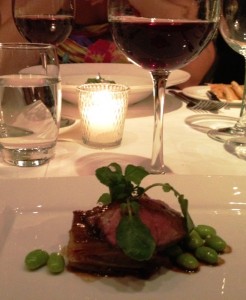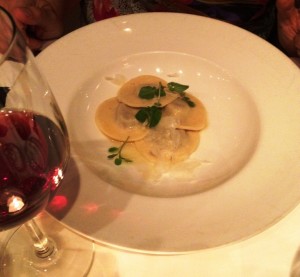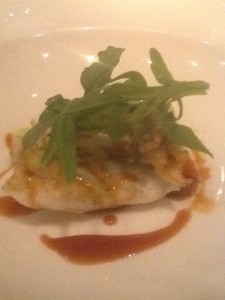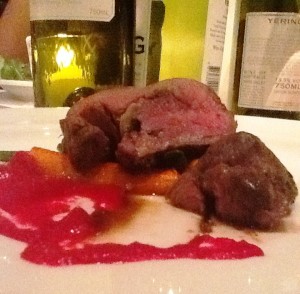Last week Sala Fine Dining on Makati Avenue joined forces with The Wine Depot to host a dinner welcoming Australian Winemaker, Willy Lunn, to Manila.
Sala has been around for about fifteen years, first in Malate, now on Makati Avenue, and in that time has gained a reputation for its excellent modern European menu, with a large fan club of gourmands. It is the baby of Scottish chef Colin McKay, who is also the owner of two of my current favourite Greenbelt restaurants: Sala Bistro and People’s Palace, which is indubitably the best Thai in town. While some people have suggested that The Mango Tree at the new end of Fort Bonifacio High Street is giving it some serious competition, I’m yet to be convinced.
Winemaker Willy Lunn is South Australian, son of a large farming family from the small town Tumby Bay on the Spencer Gulf. He moved to Victoria’s Yarra Valley in 2008 to become Chief Winemaker for the family-owned winery Yering Station, just an hour’s drive north east of Melbourne
Yering Station was originally a cattle farm, owned by two Scottish brothers, who planted the first vines there in 1838. Ten years later it had become Victoria’s first commercial vineyard. Sadly, it was hit hard by the devastating phylloxera epidemic that wiped out thousands of vines across the south eastern corner of Australia in the early twentieth century. It was not until the 1970s that wine making was re-introduced to the region, where it has thrived ever since.
Yering Station has been owned by the Rathbone family since 1996, who has been systematically adding to its stable of wineries for more than fifteen years: Mount Langi Ghiran in the Grampians; Parker Estate, in the Coonawarra, and, most recently, Xanadu Estate in the Margaret River region of Western Australia. Tonight’s wines, however, all came from the Yarra Valley.
As we gathered on the terrace, we were greeted with a glass of perfectly chilled Little Yering Chardonnay, 2010. Forever a loyal chardy girl, I must confess to a nostalgic yearning for the buttery, heavily oaked chardonnay of yore, but tonight I was perfectly content with this fresh, fruity, unoaked chardonnay, a lightly acidic wine with no residual sugar to balance the hot heavy air that promised an imminent thunderstorm. Several warning drops persuaded us it would be wiser to go inside, where we settled ourselves behind a battalion of wine glasses.
Topped up with the Chardonnay to accompany our entrées, we gazed adoringly on a beautiful arrangement of Davao goat’s cheese and crisp squash flowers splashed with candied orange & date molasses. It was a mouth-watering combination of textures and tastes: the soft cheese versus the crunch of the lightly fried squash flower, the sharply sweet tang of the orange and date molasses. Our only sadness was how quickly it vanished.
Willy Lunn is a confident, amusing speaker, who waxes charmingly lyrical about his wines. He kept claiming he didn’t want to bore us and yet I didn’t hear a solitary soul suggest he had. Everyone agreed he had been highly entertaining and we were all sorry he didn’t take the stage for longer.
As I all but licked the plate clean of molasses, waiters poured the first Pinot Noir before handing out the Membrillo glazed duck breast with roast vegetables and duck confit pavé. Membrillo is a quince paste, and pavé, I discovered, is a French cooking term referring to a square or rectangular-shaped serving of food, and meaning, literally, cobblestone.
The accompanying Pinot was surprisingly light, perhaps a little too light for the rich duck, but a second glass was filled with a Village Pinot Noir 2010 that, for me, worked much better. Both are 2010 Pinots, mid valley/ valley floor both 100% pinot, but while the first tasted young and sharply fruity, the second was softer, generously flavoured with black cherry, succulent and savoury, with greater depth and flavour. Winemaker Lunn described pinot noir as sensitive: it needs gentle hands and east facing slopes to get the early morning sun, but protected from strong sun. He says it can be a ‘rewarding variety’.
The grand finale is a Little Yering Cabernet Shiraz 2010 from the valley floor, a good match for Chef’s full-flavoured anchovy and rosemary roast lamb rump, with roast carrots and a ballsy purée of beetroot, horseradish and mustard. Willy described it as old Aussie claret: an uncomplicated, medium-bodied ‘spaghetti red’. He used lovely descriptors: ’tomato bush herbaciousness’ with traces of anise. It’s not as meaty as a Barossa Shiraz, he explains, but softer drinking, with a lighter mineral component and structured tannin.
Later, he talked to us about growing up on a farm primarily focused on wheat and cattle, and expressed his delight to be part of an industry where he gets to follow the product all the way to the table.
At our table, the glasses are almost empty, stained with red wine and lipstick, but Chef Colin has not quite finished mixing his own brand of magic in the kitchen. The Tarte tatin with stem ginger ice cream was melt-in-the-mouth delicious, especially for anyone, like me, with a particular fondness for the combination of ginger and apple. Light and flaky pastry crumbled delicately against the teeth, melting into the heavy, rich, caramel-sweet cooked apple.
With a final flourish, the waiters shared out a tray of delectable Earl Grey macaroons with coffee, and we were replete with fabulous food, wonderful wines and cultured conversation!




